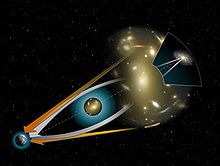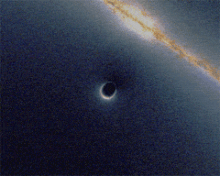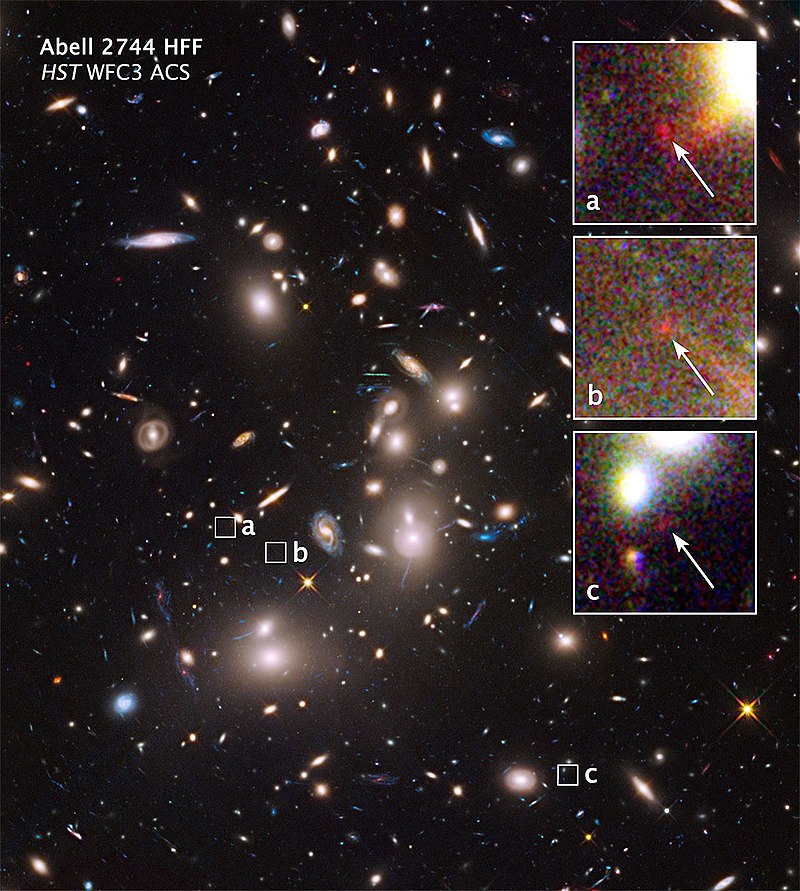A
light source passes behind a gravitational lens (point mass placed in
the center of the image). The aqua circle is the light source as it
would be seen if there was no lens, white spots are the multiple images
(or Einstein ring) of the source.
A gravitational lens is a distribution of matter (such as a cluster of galaxies)
between a distant light source and an observer, that is capable of
bending the light from the source as the light travels towards the
observer. This effect is known as gravitational lensing, and the amount of bending is one of the predictions of Albert Einstein's general theory of relativity. (Classical physics also predicts the bending of light, but only half of that predicted by general relativity.)
Although Einstein made unpublished calculations on the subject in 1912, Orest Khvolson (1924), and Frantisek Link (1936)
are generally credited with being the first to discuss the effect in
print. However, this effect is more commonly associated with Einstein,
who published an article on the subject in 1936.
Fritz Zwicky
posited in 1937 that the effect could allow galaxy clusters to act as
gravitational lenses. It was not until 1979 that this effect was
confirmed by observation of the so-called Twin QSO SBS 0957+561.
Description
Unlike an optical lens,
a gravitational lens produces a maximum deflection of light that passes
closest to its center, and a minimum deflection of light that travels
furthest from its center. Consequently, a gravitational lens has no
single focal point,
but a focal line. The term "lens" in the context of gravitational
light deflection was first used by O.J. Lodge, who remarked that it is
"not permissible to say that the solar gravitational field acts like a
lens, for it has no focal length".
If the (light) source, the massive lensing object, and the observer lie
in a straight line, the original light source will appear as a ring
around the massive lensing object. If there is any misalignment, the
observer will see an arc segment instead. This phenomenon was first
mentioned in 1924 by the St. Petersburg physicist Orest Chwolson, and quantified by Albert Einstein in 1936. It is usually referred to in the literature as an Einstein ring,
since Chwolson did not concern himself with the flux or radius of the
ring image. More commonly, where the lensing mass is complex (such as a galaxy group or cluster)
and does not cause a spherical distortion of spacetime, the source will
resemble partial arcs scattered around the lens. The observer may then
see multiple distorted images of the same source; the number and shape
of these depending upon the relative positions of the source, lens, and
observer, and the shape of the gravitational well of the lensing object.
There are three classes of gravitational lensing:
1. Strong lensing: where there are easily visible distortions such as the formation of Einstein rings, arcs, and multiple images.
2. Weak lensing:
where the distortions of background sources are much smaller and can
only be detected by analyzing large numbers of sources in a statistical
way to find coherent distortions of only a few percent. The lensing
shows up statistically as a preferred stretching of the background
objects perpendicular to the direction to the centre of the lens.
By measuring the shapes and orientations of large numbers of distant
galaxies, their orientations can be averaged to measure the shear
of the lensing field in any region. This, in turn, can be used to
reconstruct the mass distribution in the area: in particular, the
background distribution of dark matter
can be reconstructed. Since galaxies are intrinsically elliptical and
the weak gravitational lensing signal is small, a very large number of
galaxies must be used in these surveys. These weak lensing surveys must
carefully avoid a number of important sources of systematic error: the intrinsic shape of galaxies, the tendency of a camera's point spread function to distort the shape of a galaxy and the tendency of atmospheric seeing
to distort images must be understood and carefully accounted for. The
results of these surveys are important for cosmological parameter
estimation, to better understand and improve upon the Lambda-CDM model,
and to provide a consistency check on other cosmological observations.
They may also provide an important future constraint on dark energy.
3. Microlensing:
where no distortion in shape can be seen but the amount of light
received from a background object changes in time. The lensing object
may be stars in the Milky Way in one typical case, with the background source being stars in a remote galaxy, or, in another case, an even more distant quasar. The effect is small, such that (in the case of strong lensing) even a galaxy with a mass more than 100 billion times that of the Sun will produce multiple images separated by only a few arcseconds. Galaxy clusters can produce separations of several arcminutes. In both cases the galaxies and sources are quite distant, many hundreds of megaparsecs away from our Galaxy.
Gravitational lenses act equally on all kinds of electromagnetic radiation, not just visible light. Weak lensing effects are being studied for the cosmic microwave background as well as galaxy surveys. Strong lenses have been observed in radio and x-ray
regimes as well. If a strong lens produces multiple images, there will
be a relative time delay between two paths: that is, in one image the
lensed object will be observed before the other image.
History
One of Eddington's photographs of the 1919 solar eclipse experiment, presented in his 1920 paper announcing its success
Henry Cavendish in 1784 (in an unpublished manuscript) and Johann Georg von Soldner in 1801 (published in 1804) had pointed out that Newtonian gravity predicts that starlight will bend around a massive object as had already been supposed by Isaac Newton in 1704 in his Queries No.1 in his book Opticks. The same value as Soldner's was calculated by Einstein in 1911 based on the equivalence principle alone.
However, Einstein noted in 1915, in the process of completing general
relativity, that his (and thus Soldner's) 1911-result is only half of
the correct value. Einstein became the first to calculate the correct
value for light bending.
The first observation of light deflection was performed by noting the change in position of stars as they passed near the Sun on the celestial sphere. The observations were performed in 1919 by Arthur Eddington, Frank Watson Dyson, and their collaborators during the total solar eclipse on May 29. The solar eclipse allowed the stars near the Sun to be observed. Observations were made simultaneously in the cities of Sobral, Ceará, Brazil and in São Tomé and Príncipe on the west coast of Africa. The observations demonstrated that the light from stars passing close to the Sun was slightly bent, so that stars appeared slightly out of position.
Bending
light around a massive object from a distant source. The orange arrows
show the apparent position of the background source. The white arrows
show the path of the light from the true position of the source.
In the formation known as Einstein's Cross, four images of the same distant quasar appear around a foreground galaxy due to strong gravitational lensing.
The result was considered spectacular news and made the front page of
most major newspapers. It made Einstein and his theory of general
relativity world-famous. When asked by his assistant what his reaction
would have been if general relativity had not been confirmed by
Eddington and Dyson in 1919, Einstein said "Then I would feel sorry for
the dear Lord. The theory is correct anyway."
In 1912, Einstein had speculated that an observer could see multiple
images of a single light source, if the light were deflected around a
mass. This effect would make the mass act as a kind of gravitational
lens. However, as he only considered the effect of deflection around a
single star, he seemed to conclude that the phenomenon was unlikely to
be observed for the foreseeable future since the necessary alignments
between stars and observer would be highly improbable. Several other
physicists speculated about gravitational lensing as well, but all
reached the same conclusion that it would be nearly impossible to
observe.
Although Einstein made unpublished calculations on the subject,
the first discussion of the gravitational lens in print was by
Khvolson, in a short article discussing the “halo effect” of gravitation
when the source, lens, and observer are in near-perfect alignment, now referred to as the Einstein ring.
In 1936, after some urging by Rudi W. Mandl, Einstein reluctantly
published the short article "Lens-Like Action of a Star By the
Deviation of Light In the Gravitational Field" in the journal Science.
In 1937, Fritz Zwicky first considered the case where the newly discovered galaxies
(which were called 'nebulae' at the time) could act as both source and
lens, and that, because of the mass and sizes involved, the effect was
much more likely to be observed.
In 1963 Yu. G. Klimov, S. Liebes, and Sjur Refsdal recognized independently that quasars are an ideal light source for the gravitational lens effect.
It was not until 1979 that the first gravitational lens would be discovered. It became known as the "Twin QSO" since it initially looked like two identical quasistellar objects. (It is officially named SBS 0957+561.) This gravitational lens was discovered by Dennis Walsh, Bob Carswell, and Ray Weymann using the Kitt Peak National Observatory 2.1 meter telescope.
In the 1980s, astronomers realized that the combination of CCD
imagers and computers would allow the brightness of millions of stars to
be measured each night. In a dense field, such as the galactic center
or the Magellanic clouds, many microlensing events per year could
potentially be found. This led to efforts such as Optical Gravitational Lensing Experiment, or OGLE, that have characterized hundreds of such events, including those of OGLE-2016-BLG-1190Lb and OGLE-2016-BLG-1195Lb.
Explanation in terms of spacetime curvature
Simulated gravitational lensing (black hole passing in front of a background galaxy).
In general relativity, light follows the curvature of spacetime,
hence when light passes around a massive object, it is bent. This means
that the light from an object on the other side will be bent towards an
observer's eye, just like an ordinary lens. In General Relativity the
speed of light depends on the gravitational potential (aka the metric)
and this bending can be viewed as a consequence of the light traveling
along a gradient in light speed.
Light rays are the boundary between the future, the spacelike, and the
past regions. The gravitational attraction can be viewed as the motion
of undisturbed objects in a background curved geometry or alternatively as the response of objects to a force in a flat geometry. The angle of deflection is:
toward the mass M at a distance r from the affected radiation, where G is the universal constant of gravitation and c is the speed of light in a vacuum. This formula is identical to the formula for weak gravitational lensing derived using relativistic Newtonian dynamics without curving spacetime.
Search for gravitational lenses
This image from the NASA/ESA Hubble Space Telescope shows the galaxy cluster MACS J1206.
Most of the gravitational lenses in the past have been discovered
accidentally. A search for gravitational lenses in the northern
hemisphere (Cosmic Lens All Sky Survey, CLASS), done in radio
frequencies using the Very Large Array (VLA) in New Mexico, led to the
discovery of 22 new lensing systems, a major milestone. This has opened a
whole new avenue for research ranging from finding very distant objects
to finding values for cosmological parameters so we can understand the
universe better.
A similar search in the southern hemisphere would be a very good
step towards complementing the northern hemisphere search as well as
obtaining other objectives for study. If such a search is done using
well-calibrated and well-parameterized instrument and data, a result
similar to the northern survey can be expected. The use of the Australia
Telescope 20 GHz (AT20G) Survey data collected using the Australia
Telescope Compact Array (ATCA) stands to be such a collection of data.
As the data were collected using the same instrument maintaining a very
stringent quality of data we should expect to obtain good results from
the search. The AT20G survey is a blind survey at 20 GHz frequency in
the radio domain of the electromagnetic spectrum. Due to the high
frequency used, the chances of finding gravitational lenses increases as
the relative number of compact core objects (e.g. quasars) are higher
(Sadler et al. 2006). This is important as the lensing is easier to
detect and identify in simple objects compared to objects with
complexity in them. This search involves the use of interferometric
methods to identify candidates and follow them up at higher resolution
to identify them. Full detail of the project is currently under works
for publication.
Galaxy cluster SDSS J0915+3826 helps astronomers to study star formation in galaxies.
Microlensing techniques have been used to search for planets outside
our solar system. A statistical analysis of specific cases of observed
microlensing over the time period of 2002 to 2007 found that most stars
in the Milky Way galaxy hosted at least one orbiting planet within .5 to 10 AUs.
In a 2009 article on Science Daily a team of scientists led by a
cosmologist from the U.S. Department of Energy's Lawrence Berkeley
National Laboratory has made major progress in extending the use of
gravitational lensing to the study of much older and smaller structures
than was previously possible by stating that weak gravitational lensing
improves measurements of distant galaxies.
Astronomers from the Max Planck Institute for Astronomy in Heidelberg, Germany, the results of which are accepted for publication on Oct 21, 2013 in the Astrophysical Journal Letters (arXiv.org), discovered what at the time was the most distant gravitational lens galaxy termed as J1000+0221 using NASA’s Hubble Space Telescope.
While it remains the most distant quad-image lensing galaxy known, an
even more distant two-image lensing galaxy was subsequently discovered
by an international team of astronomers using a combination of Hubble Space Telescope and Keck telescope imaging and spectroscopy. The discovery and analysis of the IRC 0218 lens was published in the Astrophysical Journal Letters on June 23, 2014.
Research published Sep 30, 2013 in the online edition of Physical Review Letters, led by McGill University in Montreal, Québec, Canada, has discovered the B-modes, that are formed due to gravitational lensing effect, using National Science Foundation's South Pole Telescope
and with help from the Herschel space observatory. This discovery would
open the possibilities of testing the theories of how our universe
originated.
Solar gravitational lens
Albert Einstein predicted in 1936 that rays of light from the same direction that skirt the edges of the Sun would converge to a focal point approximately 542 AUs from the Sun.
Thus, a probe positioned at this distance (or greater) from the Sun
could use the Sun as a gravitational lens for magnifying distant objects
on the opposite side of the Sun. A probe's location could shift around as needed to select different targets relative to the Sun.
This distance is far beyond the progress and equipment capabilities of space probes such as Voyager 1, and beyond the known planets and dwarf planets, though over thousands of years 90377 Sedna
will move farther away on its highly elliptical orbit. The high gain
for potentially detecting signals through this lens, such as microwaves
at the 21-cm hydrogen line, led to the suggestion by Frank Drake in the early days of SETI that a probe could be sent to this distance. A multipurpose probe SETISAIL and later FOCAL was proposed to the ESA in 1993, but is expected to be a difficult task.
If a probe does pass 542 AU, magnification capabilities of the lens
will continue to act at farther distances, as the rays that come to a
focus at larger distances pass further away from the distortions of the
Sun's corona. A critique of the concept was given by Landis,
who discussed issues including interference of the solar corona, the
high magnification of the target, which will make the design of the
mission focal plane difficult, and an analysis of the inherent spherical aberration of the lens.
Measuring weak lensing
Galaxy cluster MACS J2129-0741 and lensed galaxy MACS2129-1.
Kaiser, Squires and Broadhurst (1995), Luppino & Kaiser (1997)
and Hoekstra et al. (1998) prescribed a method to invert the effects of
the Point Spread Function (PSF) smearing and shearing, recovering a
shear estimator uncontaminated by the systematic distortion of the PSF.
This method (KSB+) is the most widely used method in weak lensing shear
measurements.
Galaxies have random rotations and inclinations. As a result, the
shear effects in weak lensing need to be determined by statistically
preferred orientations. The primary source of error in lensing
measurement is due to the convolution of the PSF with the lensed image.
The KSB method measures the ellipticity of a galaxy image. The shear is
proportional to the ellipticity. The objects in lensed images are
parameterized according to their weighted quadrupole moments. For a
perfect ellipse, the weighted quadrupole moments are related to the
weighted ellipticity. KSB calculate how a weighted ellipticity measure
is related to the shear and use the same formalism to remove the effects
of the PSF.
KSB's primary advantages are its mathematical ease and relatively
simple implementation. However, KSB is based on a key assumption that
the PSF is circular with an anisotropic distortion. This is a reasonable
assumption for cosmic shear surveys, but the next generation of surveys
(e.g. LSST) may need much better accuracy than KSB can provide.













